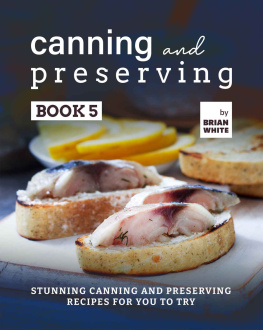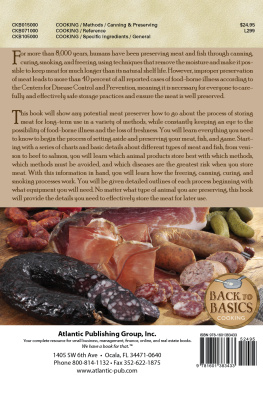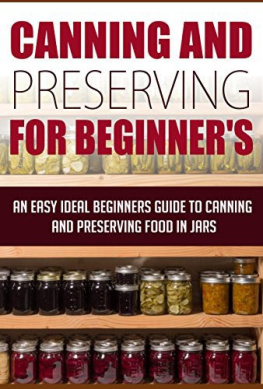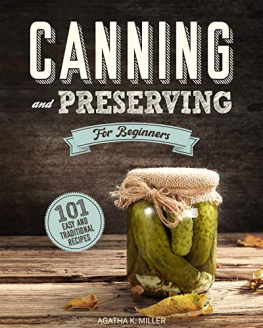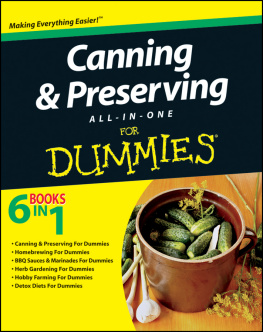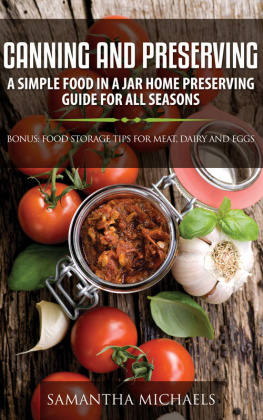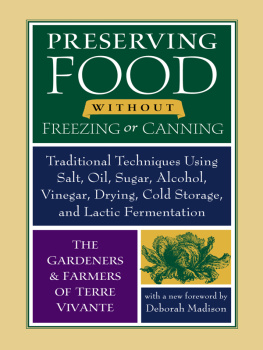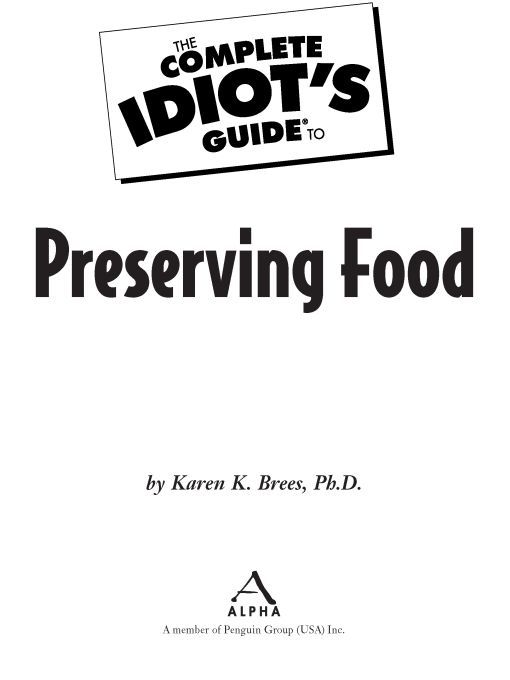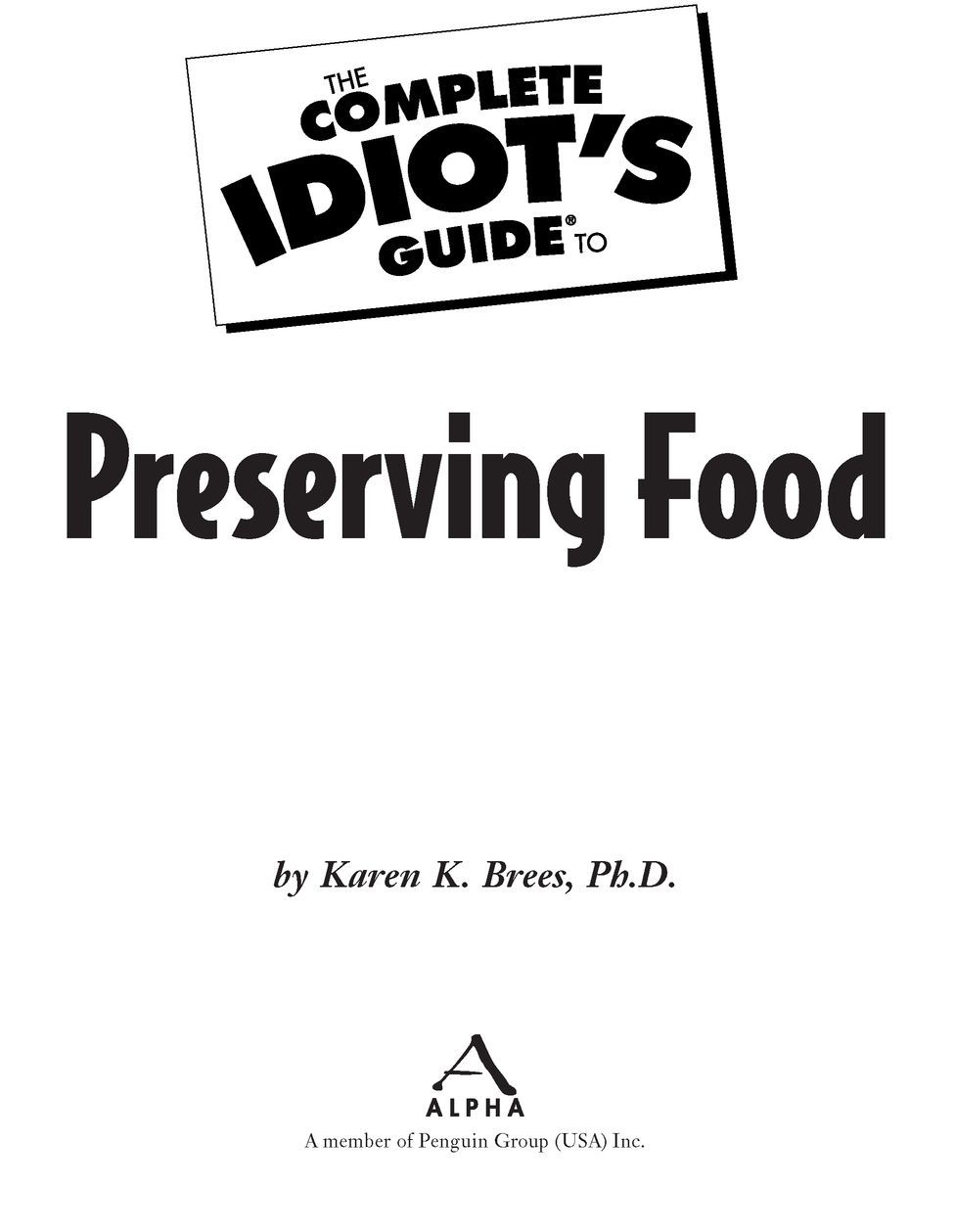Table of Contents
To my mother-in-law, the late Frances Briggs Brees, who showed me how to begin.
Introduction
Home food preservation is enjoying a remarkable surge in interest as people look for ways to cut costs, eat healthier foods, and eliminate unnecessary additives and preservatives from their diets. Combined with the increased interest in home gardening, the expansion of bulk foods warehouses, and the burgeoning growth of farmers markets, the timing couldnt be better to begin preserving food at home.
Some of us learned to preserve foods by watching our mothers and grandmothers, asking questions, and peeling countless apples and pears while we apprenticed in this art. Others of us didnt have that early experience and came to home food preservation via books or classes taught by experts in the field. However it happened, we got hooked.
The saying, Life is hard by the yard; its a cinch by the inch, applies nicely to learning how to preserve foods. Take it one step at a time, follow the directions, use tested and approved recipes, and youll be a pro before you know it.
Its fun. Sometimes that part of putting up food gets overlooked. Its a hobby that pays you back instead of costing you bucks. It lets you get creative with gift possibilities. And not to put too fine a point on it, it lets you play with food.
Whatever your reasons for perusing this book, youve come to the right place if you want to get started putting food by, as the old phrase used to say. If you have any questions about preserving and you dont find them answered here, drop me a line and Ill do my best to answer them. Thats what a food safety advisor and master food preserver for the Cooperative Extension Service does. You can reach me at karenbrees@yahoo.com. I look forward to hearing from you. Happy preserving!
How to Use This Book
The chapters in this book are organized into six main parts, with each one representing one aspect of food preservation:
Part 1, To Your Health, discusses the many reasons for preserving food at home. Youll discover the many methods available for putting up food, plus important safety procedures for protecting your preserved foods.
Part 2, Freezing, provides a great starting place for the novice home food preserver. Youll learn essential procedures, get experience, and gain confidence. Pick your own produce or patronize the farmers market, and youll start with the freshest ingredientsthe key to great-quality frozen foods.
Part 3, Canning, raises the ante. With the basics under your belt, youre ready to move to the next level. Youll learn how to fill your pantry with nutritious foods at a fraction of their grocery store prices.
Part 4, Pickles, Relishes, and Fermented Foods, shares the secrets of pickling and fermenting and gives you choices of traditional or quick recipes to add just the right touch to complete your main courses.
Part 5, Fruit Spreads, celebrates the wonderful world of jams and jellies, conserves and chutneys. Get the whole family involved and start a new family tradition.
Part 6, Drying, Salting, Smoking, and Root Cellaring, takes you on a quick trip through time. Youll explore ancient methods of preserving foods, although with a decidedly modern twist. Complete your food preserving repertoire with one or more of these methods.
Following the chapters, youll find some helpful information in the appendixes:
Appendix A is the glossary. If youre stumped by an unfamiliar term, heres where youll find the answer.
Appendix B lists abbreviations for cooking terms and also gives you a handy list of equivalencies.
Appendix C is the syrup chart, which gives you exact amounts of sugar and water to create different syrup strengths.
Appendix D gives you the recommended processing times for different foods. It includes recommendations for when to use boiling water or the pressure canner.
Appendix E is a handy reference for recommended freezer storage times for different foods.
Appendix F gives you the best methods for preserving different types of foods.
Appendix G provides additional resources to help you expand your food preserving knowledge.
Extras
Throughout the book, youll find important tidbits of knowledge to make the job of preserving food easier. These include the following:
Food science has its own special terms and phrases. Here youll find out just what they mean.
Preserving Pointers
These are helpful tips and suggestions to make food preserving fast, fun, and easy.
In Other Words
Gain time-honored wisdom and fresh advice from experienced food preservers.
Safety Check
Heed these cautions and concerns to keep you on the right track.
Acknowledgments
Id like to thank Jane Marrs for reading and critiquing; Ardis Boll and Pam McGarry for help with the pictures; Joey Peutz, Extension Educator-Food and Consumer Science, for answering all my questions; Bob Hill and Rita Peders, from May Hardware, McCall, Idaho, for the loan of the modern pressure canner; L & L Custom Meats, New Meadows, Idaho, for the meat-wrapping lesson; C & M Lumber, New Meadows, Idaho, my local source for canning supplies; John W. Brees, my husband, for his patience in formatting photos; Andrea Hurst, my literary agent; Paul Dinas, Senior Acquisitions Editor for Alpha Books; Lynn Northrup, Development Editor; Kayla Dugger, Production Editor for Alpha Books; and Amy Lepore, Copy Editor.
Trademarks
All terms mentioned in this book that are known to be or are suspected of being trademarks or service marks have been appropriately capitalized. Alpha Books and Penguin Group (USA) Inc. cannot attest to the accuracy of this information. Use of a term in this book should not be regarded as affecting the validity of any trademark or service mark.
Part 1
To Your Health
Food nourishes our bodies, provides comfort, and binds us together in shared traditions. Of all the reasons to preserve food, the most important is health. In Part 1, well take a look at what food preservation is. Well also review some of the basic principles of food safety.
Chapter 1
What Is Food Preservation?
In This Chapter
The many definitions of food preservation



